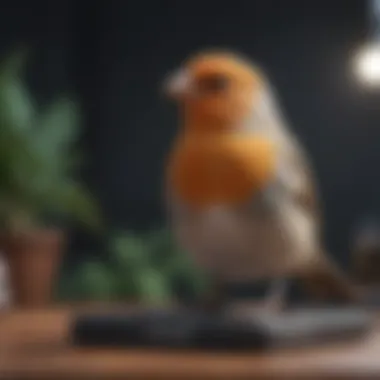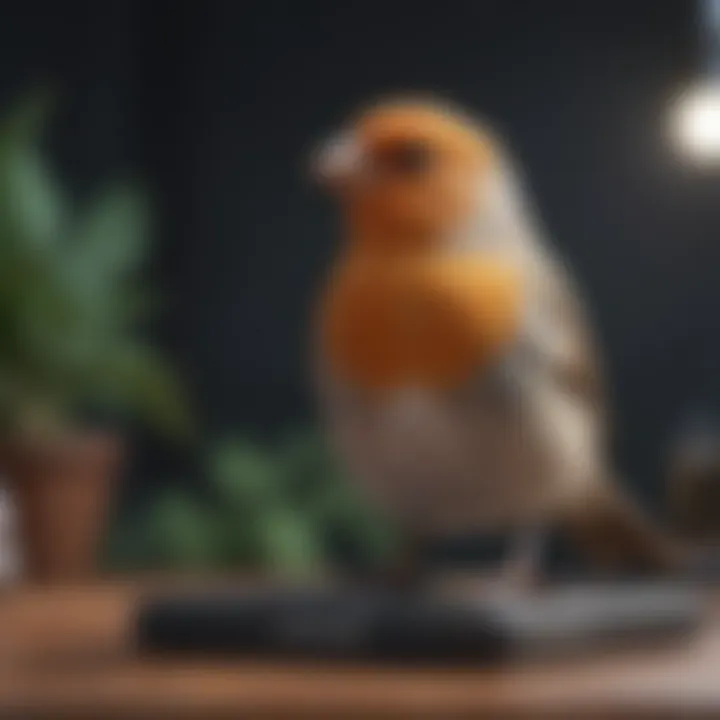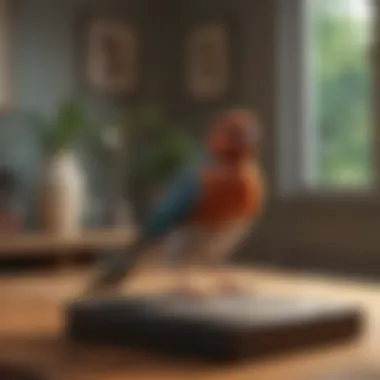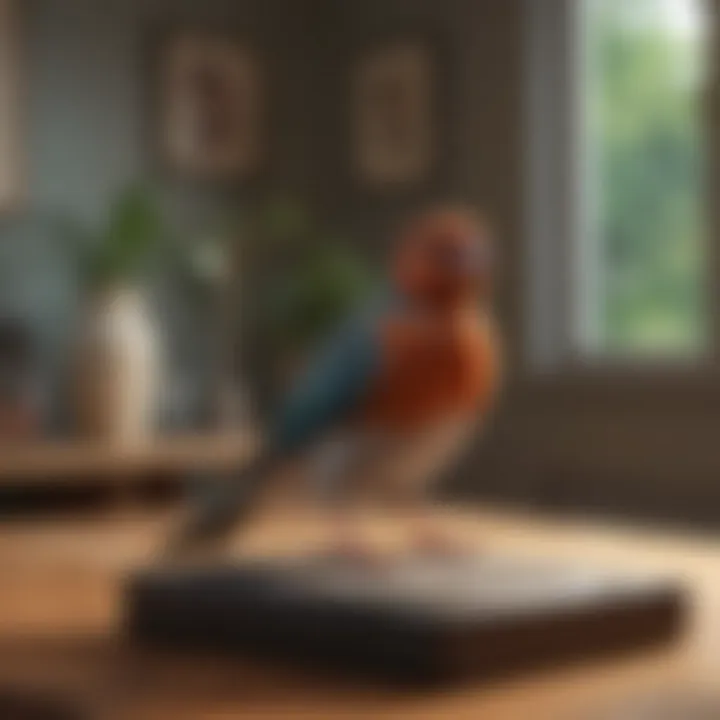Understanding Pet Bird Sound Levels and Vocalizations


Intro
The sounds that birds make can be influenced by various factors, including their species, age, and environment. Certain birds are known for their melodious songs, while others may produce loud squawks or chatter. Knowing the potential sound levels can impact decisions regarding bird selection, housing, and interactions with neighbors.
In this article, we will explore the sound dynamics of popular pet bird species, the factors affecting their vocalizations, and the implications of those sounds on daily life. By gaining insights into these auditory characteristics, pet owners can enhance their experience and foster a more nurturing environment for their feathered companions.
Care Tips
Caring for pet birds goes beyond feeding and cage maintenance; understanding how their sound levels integrate into daily routines is key. Here are some essential care tips for potential and current bird owners:
Daily Care Routines
Daily care routines for birds should consider their vocal behaviors. Spending quality time with your birds can help manage their sound levels. Birds often need social interaction, which can reduce excessive vocalization. Engage with them for at least an hour daily. This interaction can include talking, playing, or simple observation.
Cage Setup and Maintenance
A well-structured cage setup can impact a bird’s comfort and noise levels. Ensure the cage is spacious enough for movement and has varying perches. Additionally, have appropriate toys to keep them occupied and mentally stimulated. Regular maintenance of the cage will also enhance the well-being of the birds.
Hygiene and Cleaning Practices
Cleaning the cage regularly is vital for health and comfort. Birds may become stressed in dirty environments, leading to increased vocalization. Daily spot cleaning and a thorough weekly clean will contribute to overall wellness. Ensure that the area around their cage is clean too, to keep your birds happy.
Seasonal Care Adjustments
Birds react to their surroundings. During different seasons, adjust their care routines. For example, in winter, birds may become quieter as they adapt to the cold. Monitor their behavior and alter their routines, ensuring they have the warmth and comfort needed.
Behavioral Insights
Understanding bird behavior provides clues about their vocal habits. It is vital to observe them closely:
Understanding Bird Body Language
Birds communicate not just through sound but also through body language. Look for signs like fluffed feathers or an open beak. These cues can indicate whether a bird feels comfortable or threatened. Proper observation allows owners to respond appropriately.
Common Behavioral Issues and Solutions
Some birds may develop annoying vocal habits if they feel neglected or bored. Offering enough engagement and exercises can reduce such behaviors. If a bird is screaming or making unnecessary noise, evaluate their environment for stressors.
Positive Reinforcement Techniques
Encouraging desirable vocalization through positive reinforcement can be beneficial. Reward your bird with treats or attention when they make pleasant sounds. This method reinforces good behavior while minimizing unwarranted noise.
Social Interaction Needs
Birds are social creatures. Ensure they have ample interaction with their owner or other birds. Lack of interaction can lead to frustration, causing them to vocalize excessively. Creating a social environment is essential for their happiness.
Nutrition Guides
Sound levels in birds can sometimes be linked to their diet. Proper nutrition can affect overall health and behavior:
Essential Diet Components
A balanced diet for birds includes seeds, fruits, vegetables, and pellets. The right nutrition can stabilize energy levels, reducing anxiety and restlessness that might contribute to excessive vocalizing.
Safe and Toxic Foods
Knowing which foods to avoid is crucial. Foods such as avocado, chocolate, and caffeine can be harmful. Ensure you have a list of safe foods to prevent accidental poisoning.
Supplements and Treats
Occasionally, add healthy treats and supplements to their diet, but don’t overdo it. Too many treats can lead to dietary imbalances, impacting both health and behavior.
Feeding Strategies for Different Species
Different bird species have unique dietary needs. Research to cater specifically to their requirements can enhance their overall health, indirectly affecting their vocal behavior.
Wellness and Health
The health of your bird can influence its sound levels. Regular health assessments are necessary:
Routine Health Checkups


Regular checkups with an avian vet can catch any potential health issues. A sick bird may alter its vocal patterns, ranging from silence to excessive calling.
Identifying Symptoms of Illness
Observation is key to identifying health issues. If your bird starts displaying sudden changes in vocalization, it’s crucial to investigate further for underlying health concerns.
Preventative Care and Vaccinations
Preventative measures, including timely vaccinations, are significant for a bird’s health. Vaccinations protect against common diseases, thus maintaining consistent behavior and vocal patterns.
Mental and Emotional Well-being
A bird’s emotional state is deeply linked to its sound level. Create a stress-free environment to keep them calm. This reduces excessive vocalization associated with anxiety.
Enriching Activities
Enrichment is essential for the mental health of birds, impacting their vocal expressions. Here are a few activities to consider:
Toys and Playtime Ideas
Provide a variety of toys to stimulate your birds. Rotate them regularly to maintain interest. Engaging toys can divert their attention from vocalizing too much, making playtime essential.
Training and Tricks
Training your bird can not only enhance your bond but can also help control excessive vocalization. Teaching tricks can occupy their minds, preventing them from calling out excessively.
Outdoor Activities and Interaction
Taking your bird outside allows them to experience new sights and sounds. This can enrich their auditory landscape and potentially reduce indoor vocal behaviors.
DIY Projects for Mental Stimulation
Creating your own toys or challenges can keep your bird engaged and interested. These projects provide mental stimulation which can be beneficial for managing sound levels.
Preamble to Pet Bird Vocalization
Pet bird vocalization is a crucial aspect of avian behavior and care. Many aspiring bird owners might overlook the significance of understanding this element before bringing a feathered friend into their homes. Good knowledge about the vocal tendencies of different species can help owners set realistic expectations. Each bird's sound levels may affect the living conditions in a household, and understanding these dynamics can be beneficial.
A well-informed owner can create an environment that aligns with both human and bird needs. Recognizing the nature of bird sounds contributes to better care. This understanding allows for informed choices regarding species selection. Additionally, it can assist in preparing for potential noise-related conflicts later on, especially in multi-tenancy situations.
In essence, knowledge about vocalization also fosters a deeper bond between the owner and their pet. Knowing the range and purpose of sounds can help owners respond appropriately to their birds. Ultimately, this aspect of bird ownership holds significance in enriching the relationship between birds and their human companions.
The Nature of Bird Sounds
Birds produce a wide array of sounds that fall into distinct categories. These sounds range from simple chirps to complex mimicking. Species like the African Grey Parrot are known for their incredible ability to imitate human speech, while others like parakeets exhibit cheerful chatter.
Each sound serves a purpose in communication, whether it be for attracting a mate, signaling alarm, or establishing territory. Consequently, understanding these vocal nuances can help owners recognize their bird's needs more effectively. Here are some common types of bird sounds:
- Chirps: Often signify contentment or alertness.
- Squawks: Serve as warnings or expressions of discomfort.
- Whistles: Can indicate playfulness or an attraction to attention.
The modulation of sound volume can vary significantly among species. Some birds are naturally louder, while others are more subdued. This behavior might be influenced by factors like environment and genetics.
Purpose of Vocalization in Birds
Vocalization serves many purposes that are vital for a bird's survival and social structure. Each call or sound has a specific function that contributes both to the bird’s well-being and social interactions.
- Communication: Birds use vocalization to communicate with one another. This can involve alerts for danger, calls to find mates, or even establishing social hierarchy.
- Territorial Claims: Many species vocalize to stake their territory. This ensures other birds understand which areas are occupied.
- Expressing Emotions: Similar to humans, birds have emotions that they express vocally. Happiness, excitement, fear, and aggression can often be detected through their sounds.
- Bonding: Vocal communication can also help strengthen bonds between mates or flock members, fostering social stability.
Understanding these aspects can help current and prospective bird owners appreciate their pet’s vocal activities as a normal and essential part of their behavior.
Factors Influencing Noise Levels in Birds
Understanding the noise levels produced by pet birds is critical for prospective and current bird owners. Different factors significantly impact this aspect of bird ownership. This section breaks down these influences and illustrates their relevance. By knowing these elements, owners can make informed decisions about the type of pet bird suitable for their living situations and lifestyles.
Species-Specific Vocal Traits
Different species of birds exhibit unique vocal characteristics that shape their overall sound levels. For instance, African Grey Parrots are known for their complex vocalizations, often mimicking sounds from their environment. On the other hand, lovebirds produce softer, less varied sounds.
These vocal traits must be a primary consideration when selecting a bird. The types of sounds they make can also have impacts on the owner's day-to-day life. Not all people enjoy loud birds, so knowing how a species typically vocalizes can help potential owners choose accordingly.
Key Points about Species-Specific Traits:


- African Grey Parrots are often among the loudest pets.
- Cockatiels are melodic but can also produce shrill calls.
- Parakeets communicate frequently and can be quite loud.
Understanding these differences guides owners to make the best choices for their homes and expectations.
Environmental Factors
The surroundings in which a bird resides can significantly influence its noise levels. Birds thrive in interactive environments, so factors like the presence of other pets or people play a part in their vocal expressions. A calm, familiar setting can lead to reduced noise, while changes in the environment, such as new visitors or unfamiliar sights, may cause increased vocalizations.
Considerable Environmental Factors Include:
- Living Situation: Urban areas can intensify vocalizations due to ambient noise.
- Room Size: Smaller spaces could amplify sounds, affecting sound perception.
- Social Interactions: Birds are social and may vocalize more in active environments.
Being mindful of these factors can enhance the overall experience of bird ownership.
Breeding and Natural Instincts
Breeding and natural instincts play a crucial role in a bird's noise levels. Many species have specific times of the year when breeding occurs, leading to heightened vocalization. This instinctive behavior is tied to mating rituals and territory establishment.
Knowing when birds are likely to be more vocal can help owners prepare for increased sound levels. Understanding these patterns leads to better management of a bird's vocalization during these periods.
Influences on Breeding and Noise Levels:
- Seasonal Breeding: Birds may vocalize more during breeding season.
- Territorial Calls: Males often call to establish dominance or territory.
- Nesting Behavior: Sounds may change when nest building occurs.
By acknowledging and adapting to these natural instincts, owners can find ways to manage noise effectively.
Understanding noise levels in birds is not just about volume; it is about the intricate relationship between species, environment, and instincts that shape their vocal world.
Common Pet Bird Species and Their Sound Levels
Understanding the sound levels of common pet bird species is essential for both current and prospective bird owners. Each species has unique vocal characteristics that can significantly affect home life. Recognizing these differences can help in choosing a bird that fits well within one's lifestyle and noise tolerance. Additionally, knowing the vocal nature of pet birds can enhance the overall experience of bird ownership by fostering better communication and understanding.
Parakeets (Budgerigars)
Parakeets are among the most popular pet birds. Their cheerful chirping can range from soft songs to louder calls. On average, they vocalize at around 60 to 70 decibels. This level is comparable to normal conversation. Parakeets thrive on social interaction, and their vocalizations can vary depending on their mood and environment. They tend to be more vocal during the day, especially if they are bored or attention-seeking. Owners should engage with them regularly to help manage their noise levels.
Cockatiels
Cockatiels are known for their sweet and melodic whistles. Their sound level generally falls between 70 to 80 decibels. This ranking places them slightly above parakeets but still within the range of a busy household. Cockatiels may mimic sounds, including whistles or short phrases. Their vocalization may be quieter during the night, creating a more tranquil atmosphere. However, they can also become quite loud, especially when they feel threatened or are excited. Owners must create a stimulating environment to keep their cockatiels content, minimizing loud outbursts due to boredom.
Lovebirds
Lovebirds are small but spirited. Their noise level can range between 70 to 90 decibels. These vocalizations can be sharp and piercing, especially during their lively playtime. They communicate frequently with their human caregivers and with each other. Lovebirds also thrive in pairs, as companionship can reduce the noise from solitary individuals who may otherwise call out for company. Understanding their vocal tendencies allows owners to prepare for the distinctive sounds they produce, which can be surprisingly loud for such small birds.
African Grey Parrots
The African Grey Parrot is renowned for its intelligence and vocal ability. Their sound levels vary significantly, generally between 80 to 90 decibels. They are capable of mimicking human voices and sounds with remarkable accuracy. The African Grey can vocalize freely during the day, necessitating dedicated interaction and enrichment to ensure they do not become excessively loud. Prospective owners need to assess their comfort with such high levels of vocalization and the potential for mimicry that can be both entertaining and challenging.
Amazons
Amazons are large parrots with loud and boisterous calls, usually ranging from 85 to 100 decibels. This places them towards the higher end of pet bird noise levels. Their vocalizations are full of character, and they can develop an extensive vocabulary. Their inherent sociability means they require a lot of attention and interaction; otherwise, they may resort to loud calling to attract attention. For those living in apartments or close quarters, understanding and preparing for the potential volume is crucial.
Potential Noise Issues for Owners
When considering pet birds, one must take into account the potential noise issues that may arise. Sound is an inherent part of a bird's life, and it can have various implications for both the birds and their owners. Understanding these aspects is crucial for creating a harmonious cohabitation environment. Owners need to contemplate how their birds’ vocalizations may interact with their living situations, personal lifestyles, and relationships with their neighbors.
Noise Sensitivity in Urban Areas
Urban environments often amplify the challenges related to noise. The presence of numerous people and buildings can create a setting where sounds are easily transmitted. Birds, depending on their species, can produce loud calls or whistles that may disturb the tranquility of an apartment complex or densely populated area. For those living in such settings, it is essential to evaluate the potential for noise complaints.
"When considering a pet bird in an urban area, the likelihood of unwanted sound interference tends to rise. Owners should assess their living space and surrounding noise levels to gauge compatibility."
Certain birds are inherently louder than others. For instance, African Grey Parrots and Amazons are known for their vocal prowess, making them less suitable for noise-sensitive environments. On the other hand, smaller species like budgerigars might be more manageable. Hence, prospective owners must do thorough research to find a species that aligns with their living conditions.
Neighbor Relations
The relationship with neighbors can be impacted significantly by pet bird noise. Common issues arise when the bird's sounds disrupt others' peace. This can lead to strained relations or formal complaints. Open communication can help mitigate these tensions. By informing neighbors about the pet bird and its potential vocalizations, misunderstandings can be reduced.
Regular monitoring of your bird’s vocal behavior, especially during different times of the day, can also help. If issues do arise, discussing acoustic adjustments is beneficial. This could involve covering cages during particularly loud spells or providing distractions to the bird, thereby minimizing noise during high-impact hours.
Personal Noise Tolerance


Every individual has a different threshold for noise tolerance. This personal aspect heavily figures into the decision to keep a pet bird. Owners must honestly assess their comfort levels with sounds, especially if living within close quarters. What may seem tolerable initially could become bothersome over time.
Some people thrive in lively environments where bird sounds contribute to their daily ambiance. Others may find such sounds distracting or stressful, particularly if they work from home or require quiet for other reasons. Making the right choice involves understanding one's limits and selecting a bird that either complements or challenges those personal preferences.
Managing Noise Levels in Pet Birds
Managing noise levels in pet birds is critical for fostering a harmonious relationship between birds and their owners. Owners often underestimate the impact of a bird's vocalization on their daily lives. High noise levels can lead to frustration, stress, and conflicts, especially in shared living environments or urban settings. By understanding how to manage these sounds, current and prospective bird owners can create a better atmosphere both for themselves and their feathered companions.
Creating a Calm Environment
A calm environment is essential for reducing excessive vocalizations in pet birds. Birds are sensitive creatures who can be influenced by their surroundings. To promote tranquility, owners should consider several factors:
- Location of the Cage: Place the bird’s cage in a quieter room away from loud appliances and heavy foot traffic. This helps the bird feel secure.
- Background Noise: Soft background music or white noise can mask sudden loud sounds. This can create a comforting atmosphere and help the bird feel less anxious.
- Interaction with Owners: Birds need social interaction. Engaging with them regularly can reduce their need to call for attention. It also helps them feel secure in their environment.
These practices not only create a serene space but also enhance the bond between the pet and its owner.
Engaging Activities to Reduce Vocalization
Keeping birds mentally and physically stimulated is essential in reducing vocalization. Engaging activities can keep them occupied and less likely to call out unnecessarily. Here are some effective strategies:
- Toys and Challenges: Provide a variety of toys that encourage problem-solving. Puzzle toys can amuse birds for extended periods.
- Foraging Opportunities: Birds enjoy searching for food. Hiding their treats in various places or using foraging toys encourages natural behaviors and distracts them from excessive calling.
- Regular Out-of-Cage Time: Allow birds to explore outside of their cages in a controlled manner. This experience reduces boredom and allows them to exhibit their natural behaviors.
Implementing these activities can significantly minimize unwanted noise by providing birds with outlets for their energy and curiosity.
Training Birds to Minimize Unwanted Noises
Training birds to understand acceptable sound levels is a blend of patience and consistency. Effective training methods can encourage birds to vocalize less in inappropriate situations. Here are some helpful steps:
- Positive Reinforcement: Reward quiet behavior with treats or praise. Positive punishment can deter unwanted noises, creating a desirable feedback loop.
- Teach Commands: Simple commands like "quiet" or "enough" can be useful. Consistently using these commands during excessive vocalization teaches birds to associate them with silence.
- Gradual Desensitization: Expose birds to typical triggers of noise incrementally. This will help them become accustomed and less reactive over time.
By following these training methods, owners can significantly reduce the instances of loud vocalizations and foster a more peaceful living environment.
Managing noise levels is not just about reducing volume; it's about creating an enriching environment that benefits both birds and owners.
Closure: The Role of Sound in Bird Ownership
The sound levels produced by pet birds form a crucial aspect of bird ownership. Understanding this dynamic not only impacts the relationship between owners and their feathered companions but also enhances the living environment. The vocalizations of birds serve multiple purposes, including communication, expressing emotions, and showcasing their natural instincts. In this conclusion, we will detail why understanding sound levels is essential for both new and experienced bird owners.
Understanding and Anticipating Noise
To start with, understanding your bird's sounds can lead to better communication. Each species has its unique vocalization patterns that reflect their moods, needs, and interactions with their environment. For example, cockatiels often chirp happily when excited, while African Grey parrots may mimic familiar sounds when trying to socialize.
By recognizing these vocal cues, owners can respond better to their birds. Anticipating their needs becomes easier. This anticipation reduces stress for both birds and owners. In more practical terms, knowing the vocalization style of a specific bird can help manage its sound levels according to the household situation, ensuring a harmonious living space.
Embracing Your Bird's Vocal Nature
Embracing the natural inclination of birds to vocalize is integral to a fulfilling ownership experience. Each sound carries significance. Recognizing that vocalization is a part of their identity can pave the way for a positive relationship.
It's crucial to foster an environment where your bird feels comfortable expressing itself. Inappropriate efforts to silence chirps or songs can harm the bond formed over time. Instead, consider providing engaging activities that satisfy your bird's need to vocalize while allowing for quieter moments too.
In sum, a comprehensive understanding of how sound plays into bird ownership informs best practices for care and interaction. By embracing the vocal nature of birds, owners can cultivate a richer, more fulfilling relationship with their pets.
"Birds are not just pets; their sounds are a vital part of their existence and our bond with them."
Ultimately, the role of sound in bird ownership underscores the need for patience, understanding, and a willingness to adapt to the unique communication styles of each species.
References and Further Reading
The topic of sound levels in pet birds is not just a matter of curiosity; it is crucial for both current and prospective bird owners. Understanding bird vocalization can significantly improve the bird-keeping experience. Proper knowledge allows owners to prepare for the auditory environment they will create and manage. This section aims to provide valuable resources that discuss bird sounds in detail, enhancing the reader’s experience and ensuring that they are well informed.
Books
Books can serve as a rich source of knowledge for bird enthusiasts. They provide detailed insights from reputable authors who often have years of experience. Some notable titles include:
- "The Complete Book of Pet Birds" by Andrew K. McDaniel
- "Birds of the World: A Photographic Guide" by Ernest F. H. Johnson
- "Birdsong: A Natural History" by Richard Örsted
These authors delve into aspects of vocalization, behavioral traits, and species variations in sound production. Reading these texts allows pet owners to gain a broader understanding of their birds' communication.
Articles and Studies
Research articles and studies can offer scientific perspectives on bird vocalizations, noise levels, and the implications for pet owners. Key articles to consider include:
- "Vocal Behavior of Budgerigars: A Study in Context" published in Avian Biology
- "Urban Environments and Avian Communication: Impacts of Noise Pollution" in Journal of Ecology
These articles can be found through academic databases such as JSTOR or Google Scholar. They discuss various factors that affect noise levels and behavior, allowing owners to navigate their birds' social needs effectively.
Online Resources
Online platforms can provide up-to-date information and community support for bird owners. Websites like Wikipedia offer broad overviews, while specialized forums on Reddit allow enthusiasts to exchange personal experiences. Some useful links include:
- Wikipedia on Bird Vocalizations
- Reddit Birdkeeping Community
These resources provide interactive help and knowledge-sharing amongst bird owners, enhancing the understanding of vocal traits and their management in everyday life.
Knowledge is a powerful tool when it comes to bird ownership. Equipping oneself with proper information ensures a better experience for both the bird and the owner.















